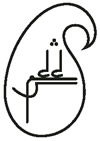
Lily Shams was born in Isfahan, Iran. She is a graduate of Sorbonne University in Paris with a degree in Fine Arts. Following a Career in fashion, she moved to New York and pursued her career as a make up artist in films and television. She had her solo exhibition and group exhibition in Seyhoun Gallery in Los Angeles in 2007, 2009, and 2010. In addition, she had several private and group exhibitions in Los Angeles, New York and Paris. She is working on her painting/drawings and Sculptures collections in Los Angeles. Lily Shams' representation of traditional Iranian symbols, imagery and caligraphy on contemporary clothing has produced a true fusion, one in which neither part looses itself or is made to compromise its essence in any way, and the result is a casual yet lavish new style that is original, suggestive, and feminine.
Working in several media and, indeed, disciplines, Lily Shams records and comments upon the places she’s been, the things she’s encountered, and the lives she’s lived. To a certain extent, of course, even the most abstract painter, the most deracinated conceptualist makes a record of experiences in their art. But Shams can be counted among those artists who dedicate their artmaking to their active relationship with the world.
With her concentration (in painting, sculpture, collage, illustration, fashion design, et. al.) on the human presence, Shams could be called a humanist artist – but for one thing. Such a label presumes the artist in question seeks to make dramatic statements about the state (current or eternal) of our species. Despite low-key inferences about human behavior, Shams’ art by and large avoids such generalities. She may respond to today’s headlines with painted compendia of celebrity and celebrity artist faces; certain of her small-scale sculptures seem like maquettes for monuments to the indomitability of the human spirit. But for the most part Shams celebrates humanity by celebrating humans. Her three-dimensional figures brim with personality and pathos. Her watercolors imagine lifetimes of intimate and familial interaction. Her multi-media objects honor her favorite writers. Her fashions dignify rather than objectify the form and the personhood of the women they are meant for. Even those parades of newsmaker heads invest a warming, distinguishing flush into otherwise-masklike visages.
Those anthological multi-portrait pictures, comprising Shams’ “Toward Awakening” series, are the artist’s current preoccupation. They have not interrupted her detailed, poignant still lives of art materials and other intimate objects; nor have they supplanted Shams’ tenderly conceived folia of imaginary (and not-so-imaginary) correspondence, with their calligraphic treatment of “ordinary” handwriting. Rather, the Toward Awakening paintings admit to one human’s admiration for and curiosity about other humans – and curiosity about the prominence those humans earned by effectively speaking for all humans, but in doing so, receding from all other humans behind the mask of fame. Is it a lingering sign of fragility we seek in staring upon these frozen, all-too-familiar visages, or is it a flash of reflection, a small acknowledgment that they are among us, come from among us, are us?
The Toward Awakening compositions are not critiques of their subjects, nor even of the process of idolization that has rendered these subjects – their masks, at any rate – universally recognizable. At the same time, although admissions of respect and even gratitude, these facial compendia do not profess blind adulation. Indeed, if anything, the series cautions against such blindness even as it manifests such adulation. The skulls interspersed with the celebrity faces amplify our associations with those celebrities, with their art and their achievements, by bearing symbolic references to (or, if you will, embodiments of) their best-known expressions. The Toward Awakening series is art about art as well as about artists.
One work in Toward Awakening evinces in no uncertain terms Shams’ investment of humanist regard into the series. It finds her for once abandoning the certain distance from her subjects – as it finds the subjects themselves abandoning that distance. The compendium of modern Persian authors Shams has realized as the fourth in the series features no portrait of any world-renowned individual. Rather, it honors, unequivocally, a heritage – a recent heritage – particular to the artist and the culture of her birth. The eleven poets and writers this Toward Awakening piece assembles brought Iran into the modern world discourse without compromising, much less abandoning, the traditions of song and metaphor traditionally associated with Persian writing. There is a special tenderness to the way Shams has portrayed them: these are not idols, but compatriots whom she loves and thanks.
Of course, in context this multi-portrait of Iranian writers is different for us, too. We know the pop musicians and radical artists and celebrity figures in Shams’ other Toward Awakening works all too well; their presences are nods of recognition between the artist and us. Here, Shams invites us to explore more deeply a cultural experience with which we are not likely to be familiar – and if we are, perhaps have put aside. Rendering the writers in precisely the same format as all the other Toward Awakening figures indicates that Shams has once more set aside judgment and comparison. But the passion in her depictions of the poets bespeaks a special relationship, one that puts the other works in the series – and, indeed, her other series – into a context of profound emotion. As coolly, even classically, as she may paint, draw, or even sculpt, Lily Shams is an expressionist, working invariably with her heart on her sleeve.
Los Angeles, July 2021 - Peter Frank
